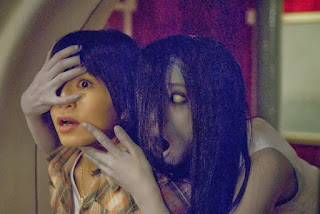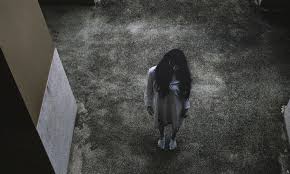White Ladies of the Western World
There is a popular motif among European countries and the Northern American Region of a ghostly figure typically referred to as "The White Lady." The White Lady anywhere the European Influence is found; Ireland, Canada, the Netherlands, though there are also instances of White Ladies in Thailand, and the Philippines. Many of these women are associated with young, violent deaths, with failures in love, or motherhood, or in some cases, buried treasure. They appear as warnings, or they appear to do harm, or they appear searching for something, such as their child; it varies from culture to culture. All of them appear in some kind of white garment, like the Korean Virgin Ghosts, that earns them their name.
Some of the ladies-in-white are based on once-living people, such as the most famous White Lady of the Czech Republic. Her legend stems from the life of Perchta of Rozmberk, a girl born to a noble family and unhappily married off at the age of 20 to Jan of Lichtenstein. Letters survive of Perchta, in which she pleads with her family for help escaping her unhappy marriage. Her husband had quite a hefty amount of debts and had expected a large dowery to be paid when he married Perchta. However, her father failed to pay as much as expected, or enough to satisfy the debts, and as a result, Jan took it out on his new wife. Her life, otherwise, was marked with misfortune. Her children died, her brothers died before her, and she died of the plague. Her fate as a ghost also stems from her husband, who is rumored to have asked her for forgiveness on his death bed. When she refuses to give it to him, he curses her, and she becomes a spirit that haunts the family's properties, most especially Rozmberk Castle. In this area, ladies-in-white are considered an overwhelmingly good figure, and after her death, Perchta became one of them. The color of her gloves often signifies the purpose of her appearance; white gloves signify goodwill, black gloves signifying a death in the family.
Perchta's real woe and the ghost tale that followed it bare resemblances to the White Lady of Malta, who was being pushed to marry a man she didn't love, and so threw herself from the cliffs on the day of her wedding. Another legend speaks of a woman who was killed by her lover after she was forced to marry another man because obviously, its her fault . Afterward she was said once the sun went down she would approach males of all ages, and treat them differently depending on their age. Young boys she'd send home to bed, but once they were teenagers or older, she began to try and entice them to join her in her shadow.
The United States has its own fair share of White Ladies, such as the Lady in White in Bedford, Virginia, who claim it is the ghost of Mary Frances "Fran" Burwell, who stayed on her porch waiting for her husband to return from the Civil War, but he never did. There are two white ladies on separate sides of the country searching for their missing children. In Rochester New York, there is the White Lady in Durand-Eastman Park, who is searching for her daughter, a girl reportedly slain by either her boyfriend, or a group of malevolent strangers. In the Golden Gate Park, near Stow Lake, there is another White Lady who will approach you and ask if you've seen her baby, a baby she supposedly dropped in the lake during the Victorian Era, and she drowned in her attempt to save.
There are other local legends, one of the most common being that women in white will appear along the high way late at night, many of which who will try to hitch-hike a ride home. These women will often appear as if they've had some sort of tragedy occur, such as the woman in white in Altoona Pennsylvania, who had an unfortunate accident near the Devil's Elbow, and appears there on foggy nights, to be picked up as a hitchhiker. She will then ask those giving her a ride if they have seen her husband. Then there's the White Lady of White Rock Lake Park in Dallas Husband, a young girl in a water-drenched 1930's white dress, that will hitch a ride asking to be brought home, only to disappear partway through.
The woman-in-white, though a global phenomenon, is colored by the different perspectives and attitudes of the times and cultures from which they came. White can come to represent purity, as it does for the good-natured women-in-white such as Petrcha, who watches over children and warns of death, or it can come to represent a curse, such as the wedding dress that indirectly caused the Malta brides' deathes, or perhaps represent unfinished business particularly for women, whether they are married or not, since many of societal beliefs about women place being a wife as their most important role; therefore a woman in the virginal white of a bride represents someone existing in a liminal space. Though Mary Frances had a husband, the fate of her husband remains unknown to her, so she is not quite a wife, not quite a widow even in death, and is therefore returned back to that liminal space, so too is the hitch-hiker who never finds her husband, or the young girl who never finds her way quite home.
Some of the ladies-in-white are based on once-living people, such as the most famous White Lady of the Czech Republic. Her legend stems from the life of Perchta of Rozmberk, a girl born to a noble family and unhappily married off at the age of 20 to Jan of Lichtenstein. Letters survive of Perchta, in which she pleads with her family for help escaping her unhappy marriage. Her husband had quite a hefty amount of debts and had expected a large dowery to be paid when he married Perchta. However, her father failed to pay as much as expected, or enough to satisfy the debts, and as a result, Jan took it out on his new wife. Her life, otherwise, was marked with misfortune. Her children died, her brothers died before her, and she died of the plague. Her fate as a ghost also stems from her husband, who is rumored to have asked her for forgiveness on his death bed. When she refuses to give it to him, he curses her, and she becomes a spirit that haunts the family's properties, most especially Rozmberk Castle. In this area, ladies-in-white are considered an overwhelmingly good figure, and after her death, Perchta became one of them. The color of her gloves often signifies the purpose of her appearance; white gloves signify goodwill, black gloves signifying a death in the family.
Pertcha
Perchta's real woe and the ghost tale that followed it bare resemblances to the White Lady of Malta, who was being pushed to marry a man she didn't love, and so threw herself from the cliffs on the day of her wedding. Another legend speaks of a woman who was killed by her lover after she was forced to marry another man
The United States has its own fair share of White Ladies, such as the Lady in White in Bedford, Virginia, who claim it is the ghost of Mary Frances "Fran" Burwell, who stayed on her porch waiting for her husband to return from the Civil War, but he never did. There are two white ladies on separate sides of the country searching for their missing children. In Rochester New York, there is the White Lady in Durand-Eastman Park, who is searching for her daughter, a girl reportedly slain by either her boyfriend, or a group of malevolent strangers. In the Golden Gate Park, near Stow Lake, there is another White Lady who will approach you and ask if you've seen her baby, a baby she supposedly dropped in the lake during the Victorian Era, and she drowned in her attempt to save.
There are other local legends, one of the most common being that women in white will appear along the high way late at night, many of which who will try to hitch-hike a ride home. These women will often appear as if they've had some sort of tragedy occur, such as the woman in white in Altoona Pennsylvania, who had an unfortunate accident near the Devil's Elbow, and appears there on foggy nights, to be picked up as a hitchhiker. She will then ask those giving her a ride if they have seen her husband. Then there's the White Lady of White Rock Lake Park in Dallas Husband, a young girl in a water-drenched 1930's white dress, that will hitch a ride asking to be brought home, only to disappear partway through.
The woman-in-white, though a global phenomenon, is colored by the different perspectives and attitudes of the times and cultures from which they came. White can come to represent purity, as it does for the good-natured women-in-white such as Petrcha, who watches over children and warns of death, or it can come to represent a curse, such as the wedding dress that indirectly caused the Malta brides' deathes, or perhaps represent unfinished business particularly for women, whether they are married or not, since many of societal beliefs about women place being a wife as their most important role; therefore a woman in the virginal white of a bride represents someone existing in a liminal space. Though Mary Frances had a husband, the fate of her husband remains unknown to her, so she is not quite a wife, not quite a widow even in death, and is therefore returned back to that liminal space, so too is the hitch-hiker who never finds her husband, or the young girl who never finds her way quite home.





Comments
Post a Comment